[unable to retrieve full-text content]
Where to eat in Hong Kong in March: yummy yakitori and a Seoul sensation StyleWhere to eat in Hong Kong in March: yummy yakitori and a Seoul sensation - Style
Read More
[unable to retrieve full-text content]
Where to eat in Hong Kong in March: yummy yakitori and a Seoul sensation StyleYou've probably felt the effects of a blood sugar spike. It's not so much the spike that you feel, but what happens afterward—the crash. It makes you feel weak, lethargic, hungry. You may experience confusion, brain fog, or a headache. And you may become ravenous with cravings for a sweet, high-calorie snack like a cookie, doughnut, or ice cream because your brain is telling you that you need more glucose.
The common analogy for this rapid rise and dive of blood sugar is a roller coaster. After you eat something, your blood sugar spikes. If you ate a simple carbohydrate, your body breaks that down into glucose very quickly and sends a surge into your bloodstream that speeds you to the top of the coaster track, just before the free fall. Then, maybe even faster than the rise, you experience the rapid drop. On a roller coaster, your stomach seems to rise into your chest. In a blood sugar dip, your brain and stomach send you hunting for a doughnut. The blood sugar roller coaster isn't much fun. If it happens a lot, in time it could lead to insulin resistance and type 2 diabetes.
For many Americans, it must happen a lot given the fact that one in 10 has diabetes and one in three, or 96 million, have prediabetes. So, what can you eat to get off the blood sugar roller coaster? Read on for a list of helpful blood sugar-stabilizing foods, and for more on how to eat healthy, don't miss The #1 Best Eating Habit That Crushes Your Sugar Cravings, Says Dietitian.
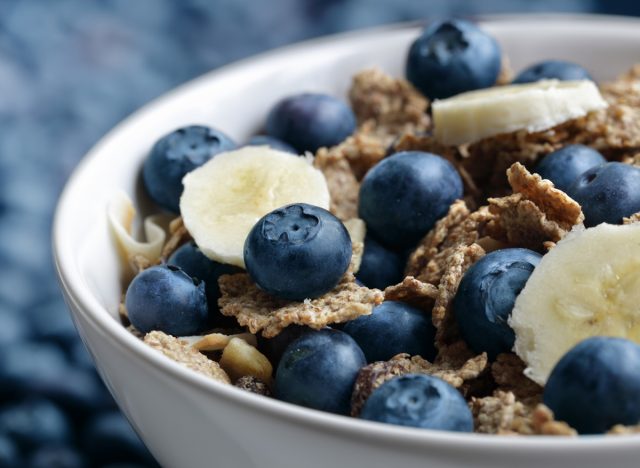
"When it comes to regulating blood sugar and avoiding spikes, high fiber foods are the place to start," says registered dietitian nutritionist Ellen Albertson, RDN, PhD, a psychologist, and wellness coach at TheMidlifeWhisperer.com.6254a4d1642c605c54bf1cab17d50f1e
Fiber is the part of plant foods that we don't digest; it slows the absorption of sugars from food into the bloodstream, which prevents spikes in blood glucose. "Studies show that people who regularly eat soluble fiber, the type that interacts with water to form a gel, had lower levels of hemoglobin A1c," says Albertson. The HA1c blood test is the most common and accurate test to diagnose prediabetes and type 2 diabetes; it measures your average blood sugar levels over the previous three months.
Breakfast is a good time to bulk up on fiber, especially if you enjoy a quick meal like hot or cold cereal. Oatmeal is a classic choice, the unsweetened kind. A serving of cooked steel-cut oats contains 4 grams of fiber. But you can do much better with a cold cereal like Fiber One, which packs 18 grams of total fiber, including one gram of soluble fiber. Soluble and insoluble fiber both support insulin sensitivity to help prevent type 2 diabetes, but soluble fiber is even stronger at improving blood sugar control.
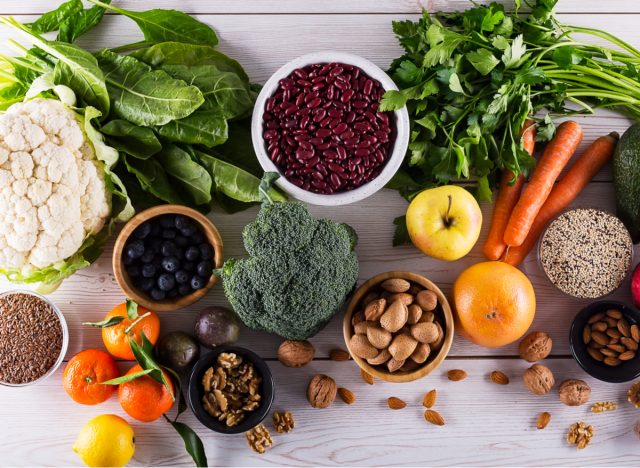
Most plant foods supply you with good amounts of dietary fiber, but some are higher in the soluble kind than others. Beans are typically one of the most robust sources of soluble fiber. For example, a three-quarter cup serving of black beans contains 5.4 grams of soluble fiber while the same portion of navy, pinto, and kidney beans all carry roughly 3 grams. Chickpeas and the hummus made from them are other good sources at 2 grams.
You'll also get a little more than a gram from servings of broccoli, carrots, apples, collard greens, peaches, potatoes, grapefruit, plums, and prunes. One-half of an avocado contains 2.1 grams of soluble fiber. So, avocado toast made with whole-grain bread is a tasty breakfast sandwich that won't spike your blood glucose.

"Although more research is needed, small amounts of cinnamon may help lower blood sugar by lowering insulin resistance," says Albertson. Several studies suggest that the tasty spice may lower fasting blood sugar levels by 10 to 20%. In one study reported in Plant Foods for Human Nutrition, researchers say cinnamon inhibits enzymes in the gut, which delays the breakdown of carbohydrates during digestion and reduces the amount of glucose entering the bloodstream after a meal. "In other words, a bowl of oatmeal with apples and nuts and a sprinkle of cinnamon on top may be the best breakfast to keep blood sugar and energy levels stable," says Albertson.
READ MORE: The #1 Best Breakfast to Lower Blood Sugar, Says Dietitian
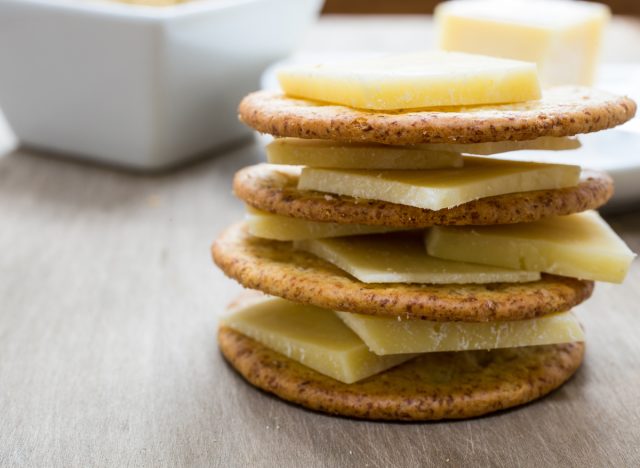
The best path to healthy blood glucose control is avoiding foods that are high in added sugars like candy, pastries, ice cream, and soda, but what about those carbohydrates that aren't clearly treats or snack foods? We're talking about rice, bread, pasta, crackers, and the like, which are prone to quickly boost blood sugar. Florida-based Su-Nui Escobar, RDN, a registered dietitian nutritionist with Evolving Dietitians, recommends combining foods high in carbs with some protein or fat. A snack of crackers (carbs) and a small serving of cheese (protein and fat) is a good example. The protein and fat will slow digestion and the absorption of the carbs into the bloodstream to avoid the sugar spike, she says.
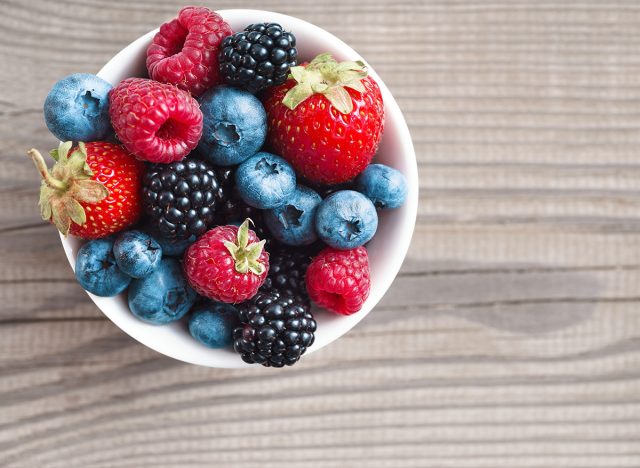
Blueberries, blackberries, strawberries, raspberries, and cranberries are among the best fruits to lower blood sugar. A study in the journal Food & Function suggests that the phytochemicals and polyphenols in berries (they're also found in colorful vegetables) may be responsible for reducing the risks of several chronic metabolic diseases, including type 2 diabetes. Researchers found that berries eaten along with or in combination with other foods lowered post-meal blood sugar levels in overweight and obese people with insulin resistance.
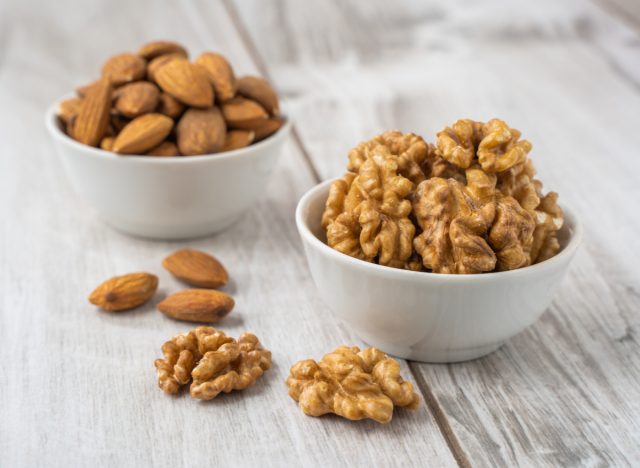
Nuts and seeds make terrific snacks for avoiding blood sugar spikes because they score a hat-trick of macronutrients: They contain fiber-rich carbohydrates, protein, and monounsaturated (healthy) fats, all of which contribute to slowing down the conversion of carbohydrates and sugars to blood glucose. Almonds and walnuts are particularly powerful anti-diabetes foods for another reason: they are high in magnesium, a nutrient that plays a crucial role in blood sugar regulation.
A study in the journal Metabolism shows that eating just 2 ounces of almonds may help reduce the rise in blood sugar and insulin levels after meals, says registered dietitian nutritionist Melissa Mitri, RDN, a contributor to the website Wellness Verge. It's believed that low levels of serum magnesium, a condition called hypomagnesemia, might worsen insulin resistance and lead to diabetes.

Hyper-sweetened teas and sugary juices have a tremendous impact on blood sugar levels, so anything you can do to replace those beverages with no-sugar options will help you steer clear of blood sugar spikes. Bone broth is a good choice because it's often carbohydrate- and sugar-free, plus it contains nutrients that improve gut health and "amino acids like glutamine, glycine, and proline that help to balance blood sugar," says Samantha Presicci, RD, LD, a registered dietitian with FOND Bone Broth.
Besides reducing blood sugar spikes, another effective strategy for preventing type 2 diabetes is losing weight, especially losing the fat that congregates around your midsection. To start dropping pounds, try these Eating Habits to Lose Abdominal Fat As You Age, Say Dietitians.
[unable to retrieve full-text content]
Eat Great Food Festival in Bay City Feb 27-March 1 nbc25news.com
Wenonah Park in downtown Bay City is full of portable igloos as the annual Eat Great Winter event gets ready to kick off three nights of dining on Sunday.
Eat Great and Dow Great Lakes Bay Invitational Special Events Coordinator Cam Wing said the heated igloos are sold out for all three nights of the food festival -- Sunday, Monday and Tuesday.
But there's a chance that more seating times could be added, he said.
"If we have high demand, we may be able to open up additional seating times," Wing said, noting that updates will be posted on eatgreatfoodfestival.com and on Instagram at eatgreatfestival.
Eight restaurants from throughout the Great Lakes Bay Region are part of Eat Great Winter, including The Creek Grill, Live Oak Coffeehouse, Whine, MI Table, DoubleTree Riverfront Grille, Heidi’s Darn Good Cookies, Fig and Honey Cheese Co., and Bayne's Apple Valley.
Each igloo seats eight diners at a cost of $600 for an eight-course meal, which includes appetizers, soup, salad, two main courses, two desserts and a coffee bar.
The proceeds of Eat Great Winter will go to Dow GLBI’s #TeamUp for the Great Lakes Bay Region charitable giving effort.
"The proceeds go back into the community," Wing said.
The third annual Dow GLBI, an LPGA Tour team event, will be held July 10-16, 2022, at the Midland Country Club.
The inaugural Eat Great Winter took place at Dow Gardens in Midland. Last year's event was canceled due to the COVID pandemic. Next year's Eat Great Winter will be held in Saginaw.
[unable to retrieve full-text content]
Eating disorders have spiked in teens during the pandemic SoMdNews.comPeople who eat less meat or stick to vegetarian diets may have a lower risk of certain cancers, suggests a study published this week in BMC Medicine.
Researchers from the University of Oxford analyzed data from 472,377 adults in the UK, aged 40-70, who did not have cancer at the start of the study. During an average of 11 years of follow-up, the researchers compared the rates of cancer diagnoses to to data on how often they ate meat, including processed meat, beef, pork, lamb, and poultry. Fish was included as a separate category.
They found that vegetarians and vegans had a 14% lower overall cancer risk, compared to people who ate meat nearly every day (more than five times a week, on average). People who ate fish, but not meat, had a 10% lower risk, and those who ate meat less frequently had a 2% lower risk.
For certain types of cancer, the difference was even more significant and a surprise to researchers, Cody Watling, lead author of the study and a PhD student at Oxford, told Insider.
The biggest shift was the prostate cancer risk for vegetarian or pescetarian men, who had a 20-31% lower risk than their meat-eating counterparts. For women, a vegetarian or pescatarian diet had the biggest impact on reducing their risk of postmenopausal breast cancer.
Watling said one hypothesis to explain the gender disparity is that men are typically less health conscious, according to prior research, and may be taking a less healthy approach to their meat-centered dishes. "It could be that women, even if they do follow a regular meat eating diet, are eating more whole grains, men may be eating more processed meats," he said.
While more research is needed to understand the link between diets and cancers, the results suggest that over time how we eat meat — including what we eat with it — may play an important role in health, Watling said.
The study is observational, which means the research is not a perfect assessment of how meat eating impacts cancer risk. Many factors could explain the link, including overall lifestyle, Watling said.
For instance, vegetarians and vegans tend to have a lower body mass index (BMI), or height to weight ratio, suggesting lower rates of obesity, a known risk factor for cancer. This partly explained the different in breast cancer rates in the study, Watling said.
However, rates of prostate cancer remained higher in the meat-eating group, even after accounting for BMI.
Vegetarians and pescatarians also tended to be younger, were more likely to be college-educated and physically active, and more often had never smoked tobacco. They also reported drinking less alcohol, which is a known cancer-causing substance,
The type of meat may also make a difference: some evidence suggests that while processed meat may increase health risks, unprocessed red meat or poultry may not.
Regardless of the type of meat you eat, however, getting a variety of plant foods in your diet has science-based benefits for lowering risks of cancer and other chronic diseases and improving overall health.
"There may potentially be a lower risk for individuals who exclude meat, but to follow a healthy diet, you don't necessarily have to exclude meat," Watling said. "Habits like eating whole grains, vegetables and legumes, and maintaining a healthy weight are things we should all be doing regardless of whether we're vegetarians or meat-eaters."
High cholesterol is no friend of ours. While your body needs a certain amount of cholesterol to form cells, having too much of it can lead to serious health conditions like stroke, diabetes, or heart disease.
And unfortunately, as you age, your risk for high cholesterol increases because your liver's ability to filter out bad cholesterol slowly decreases.
If you currently have high cholesterol, are above the age of 50, or know that it runs in the family, there are simple dietary changes you can make that may help you significantly.
We talked with a few dietitians to get their advice on eating habits you should avoid if you want to lower your cholesterol after 50, with some tips on helpful habits as well.
And for more heart-healthy tips, check out The Best Foods to Eat For Your Heart.
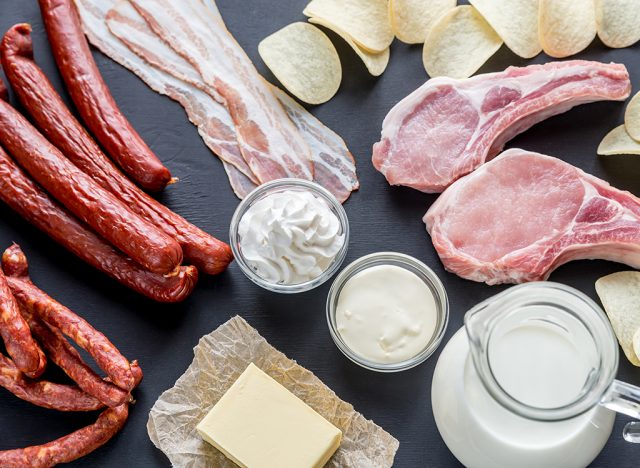
Limiting the amount of saturated fat you consume has been proven as an effective method in helping to lower and manage cholesterol.6254a4d1642c605c54bf1cab17d50f1e
"While many people think that dietary cholesterol increases your blood levels of cholesterol, that is actually false," says Amy Goodson, MS, RD, CSSD, LD, author of The Sports Nutrition Playbook, and a member of our medical expert board. "One of the biggest contributors to high cholesterol is the consistent intake of saturated fat. You find saturated fat in the skin on chicken, the marbling and visible fat in and on beef and pork, full-fat dairy foods, pastries and baked goods made with butter and cream, and fried foods, as well as in coconut, palm, and palm kernel oils."
"It's not to say you can't ever eat saturated fat, but the American Heart Association and Dietary Guidelines for Americans say that saturated fat should count for 10% or less of your total calories," she continues.
The American Heart Association also recommends replacing saturated fats with plant-based proteins like legumes, liquid vegetable oils, and lean poultry without the skin.
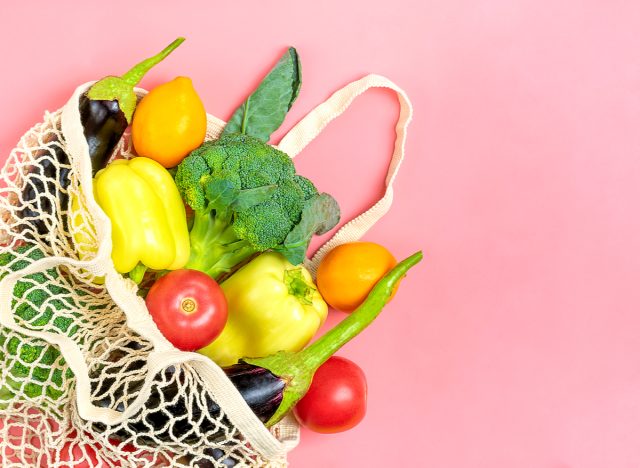
A common mistake that many Americans make is not eating enough fruits and vegetables each day, but our dietitians warn that this habit can hinder your goal of trying to lower your cholesterol levels.
"Fruits and veggies contain high amounts of antioxidants, which have shown to lower LDL cholesterol levels by reducing LDL oxidation and preventing the formation of plaque in your arteries," says Courtney D'Angelo, MS, RD, author at Go Wellness. "There are plenty of ways to add extra fruit into your daily diet and create a great habit out of it. For example, you can make a protein smoothie in the morning and add blueberries, strawberries, or your choice of fruit."
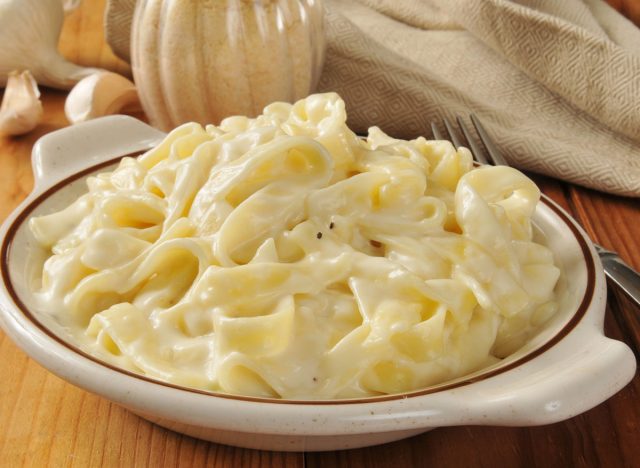
Dietitians also recommend if you're someone who loves creamy salad dressings or sauces, you may want to limit your consumption or look for types that are made with less saturated fat.
"Many people don't realize that their salad dressings, sour cream on tacos, and Alfredo sauce on pasta are often very high in saturated fat and calories," says Goodson. "Plus, what's really challenging is that sometimes you cannot see these foods as they are baked or cooked into desserts and sauces. However, these foods and ingredients are often high in saturated fat, which when eaten consistently, can contribute to an increase in total and bad cholesterol."
Here's The #1 Worst Oil for Cholesterol, Says Science.
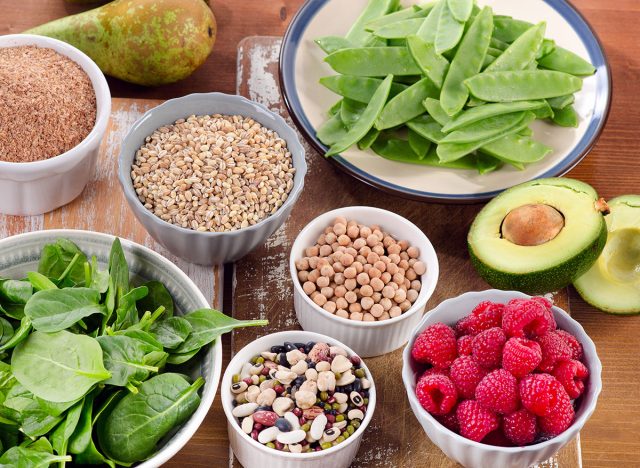
Eating a consistent amount of fiber every day is key for managing cholesterol because fiber is what helps your body not absorb as much cholesterol into the bloodstream.
"There are plenty of soluble fiber foods that you can incorporate into your diet today, such as oatmeal," says D'Angelo. "Oatmeal contains a high amount of soluble fiber, which can reduce the bad cholesterol (LDL cholesterol). If you start eating oatmeal every day for breakfast, you can get 3 to 5 grams of fiber per meal. You can then add fruit to your oatmeal and get even more fiber."
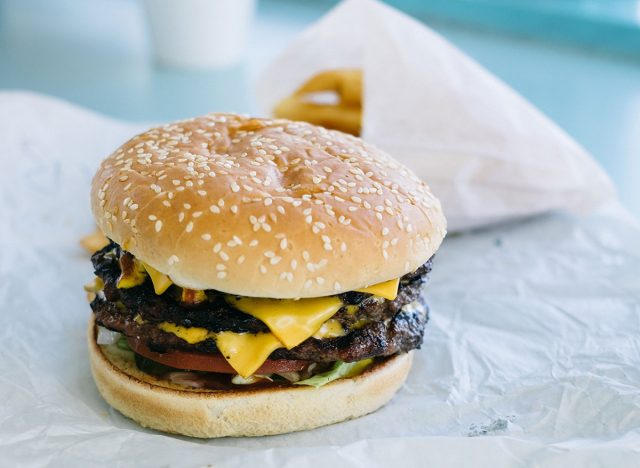
Fast food is one of the worst things you can eat when you're trying to lower your cholesterol. Not only is it loaded with fat, but the sodium content is through the roof.
"While there are some "better-for-you" options in the drive-thru like grilled chicken salads, sandwiches, and wraps, more fast food options than not have lots of saturated fat, which can contribute to increased bad (LDL) and total cholesterol levels when consumed regularly," says Goodson.
For more healthy eating tips, check out our list of 22 Meals to Melt Belly Fat in 2022.
Tune into our episode of “Eat Play Stay” on State College for all the college-town flavor just a few hours from Pittsburgh.
Lincoln Caverns sit just south of State College in Huntingdon. Discovered in 1930, this family-owned and operated cave is full of underground wonders and fabulous formations. Stop by the gift shop on your way out for a glistening selection of minerals and souvenirs.
Webster’s is truly a one-stop-shop. From coffee to books to vintage goods, this downtown spot has it all. For veggie lovers, Webster’s café specializes in delicious vegetarian and vegan fare. Grab an oat milk latte and put on a record — Webster’s is designed to feel like a community living room.
Located just north of State College in Bellefonte, Our Fair Lady is a B&B housed in a Victorian mansion. Owners Bob and Tami Schuster have lovingly restored this house to its 1883 glory. Come for the Scrabble, stay for the homecooked breakfast with local veggies. If you’re lucky, you can even try the Schusters’ homemade wine.
Urbn Flavourhaus serves up everything from coffee beans to bountiful burgers. From pancake tacos to their signature Freak Shakes, Urbn Flavourhaus has a treat for every craving. The Freak Shakes are like a full meal — try one with a traditional Central PA sticky bun perched on top!
For a plant-based taste of summer in State College, stop by Playa Bowls. They offer fresh ingredients piled together in a Nutella bowl or blended into healthy smoothies. Playa Bowls is an oasis of freshness right near Penn State’s campus in Downtown.
Gamble Mill in Bellefonte is home to a restaurant, bar, inn and suites. While this building used to be a working grist mill, now it churns out craft cocktails from the speakeasy downstairs. Gamble Mill is equal parts fascinating history and cool contemporary vibes, much like the State College area itself.
[unable to retrieve full-text content]
Let’s Eat at Claudio’s Bistro in Woodruff WSPA 7NewsFor years, there’s been talk that the block of bars and parking lots sandwiched between West 6th and West 7th streets near University Drive would eventually meet their demise, paving the way for something bigger and out of character with the industrial layout of the entertainment district. News began to leak in late 2021 that notable stalwarts the Landmark Bar, The Yard, and Magnolia Motor Lounge — the only source of live, mostly original music on this side of 7th — would be replaced by a mixed-use development. Groundbreaking on the aptly named Van Zandt is set to begin in March.
With an immediate live-music void — unless you want to cross 7th to Lola’s Trailer Park and Saloon, and why wouldn’t you? — the West 7th area has seen the formation of a more streamlined area along Foch Street, where spots such as Pour Decisions, Junk Punch, and The Backyard have joined the already-existing Lottie’s, Whiskey Garden, and Hooky, with Bottled Blonde’s opening not far behind. The recent addition of Austin-based good time spot The Dogwood has helped cement this densely packed two-block area with plenty of late-night — and even mid-morning — options.
“We’re excited about opening in Fort Worth for multiple reasons,” said Chad Womack, who owns The Dogwood with twin brother Brad Womack, “and not just for the city itself but the West 7th Street district in particular. There is a cool, energetic vibe within the city of Fort Worth, and we strive to earn our place as a part of it all. The Dogwood has always attracted a good, diverse crowd, mixed with young professionals, college students, and tourists, all of which Fort Worth has plenty of.”
The Womacks and operating partner Preston Enders run The Dogwood — with two locations in Austin and one each in Houston and Nashville — and nearly a dozen other concepts. The Fort Worth location achieves a Western tone, complete with a stage, without overdoing it. And yet The Dogwood still incorporates kitschy Instagrammable sights such as a stripper pole near the entrance and a pink neon sign requesting to “send nudes.”
The Womacks are aware that while they can’t really replace MML, they can still offer original musicians a home on the other side of Lola’s.
“Without being a live music-only bar,” Brad said, “there’s a happy medium where a band or artist can play early in the evening, then we transition to having a DJ for the late hours.”
Unlike the well-worn, grungy, intimate feel of the Motor Lounge, the fresh aesthetic worked well during The Dogwood’s grand opening last month, when Texas Music star Roger Creager played a two-hour set before a DJ took over. The bar was packed most of the night.

Plenty of TVs dot the space, with two bars as well as a patio outfitted with seating and more TVs. There are lots of game-watching specials, and the menu is pretty standard bar food with some fun twists (sweet tea-marinated wings, chicken and waffle sliders, jalapeno mac with ground beef or chicken, grilled or fried). During happy hour (4pm-7pm Mon-Fri), a lot of items are only $6, including Cajun chicken fritters and smothered tater tots.
Signature cocktails, topping out at $12, feature spins on classics. The Dogwood Flower is a mix of vodka, St-Germain, and Waterloo grapefruit sparkling water with a fresh squeeze of lemon, and rye, peach vodka, ginger liqueur, and peach bitters go into the Southern Belle Manhattan. If you’re craving a light and fizzy brunch beverage that isn’t a mimosa, the Violet Rose (gin, lychee liqueur, blueberries, sparking rose) will more than satisfy.
And brunch — this place is built for brunch. Basic biscuits come as a pair with house-made gravy for $8, or, for a dollar extra, you can inhale the Chick’n Biscuit with whipped honey butter. When Taco Bell doesn’t do the trick during the wee hours of the morning, the Hair of the Dogwood has you covered with a face-sized burrito loaded with bacon, scrambled eggs, home fries, and cheese, all topped with queso and gravy for $10. That’ll get your digestive system back on track in no time and ready for the evening.
The Dogwood
1100 Foch St, FW. 512-573-5510. 11am-2am daily.
All major credit cards accepted.
/cloudfront-us-east-1.images.arcpublishing.com/pmn/2J75BNJAVFC43NGF2VEI6PH6DQ.jpg)
Eating disorders are complex medical and mental health conditions that can affect people of any age, gender and race.
Though they affect some 30 million people, eating disorders are often misunderstood.
“What most people miss with all of this is it just goes deeper than the way we eat. It goes deeper than the need to be in control,” said Brian Pollack, the founder and clinical director of Hilltop Behavioral Health in Summit, NJ. “It gets to the core of what it is to feel comfortable in this ever-evolving roles and gendered experiences we are kind of thrown into.”
The stigma around eating disorders can make it harder for people to reach out for help or feel comfortable talking about.
ADVERTISEMENT
“One of the most isolating and challenging things for me was I couldn’t find representation for men with eating disorders,” said William Hornby, a 22-year-old Temple student who recently spoke with the Inquirer about his experience with an eating disorder. “Even though I knew it was happening, I couldn’t find them.”
Medical providers and patients agree that talking more about eating disorders can dispel myths about them and help people struggling feel comfortable seeking medical attention.
Here’s what to know:
» READ MORE: Eating disorders among men are more common than you may think. But it’s hard to find help.
Eating disorders are a group of medical illnesses related to severe disturbances to a person’s eating, according to the National Institute of Mental Health. Genetic, behavioral, psychological and social factors can contribute to eating disorders, though researchers do not know the exact cause.
People with eating disorders may appear healthy. It is a misconception that everyone who has an eating disorder loses weight. Anorexia nervosa, one well-known eating disorder in which people severely restrict food or avoid eating is associated with weight loss.
Signs of an eating disorder include a fixation or obsession with body weight and shape, and strict regulation of food. Not everyone with an eating disorder restricts food — some may eat only specific foods, binge on food, or binge and then “purge” through excessive exercise, fasting, or forced vomiting.
Eating disorders are treatable. Psychotherapy, nutrition counseling, and medication are common treatments for eating disorders. Support from family members and friends can greatly aid in recovery, according to the National Institutes of Mental Health.
To get help with an eating disorder talk to your doctor or mental health provider, if you have one. For help finding a provider, call Substance Abuse and Mental Health Services Administration (SAMHSA) Treatment Referral Helpline at 1-800-662-HELP (4357). The National Association of Anorexia Nervosa and Associated Disorders has a free helpline (1-888-375-7767) takes calls from people who need support or referrals, think they they have an eating disorder or think someone else has an eating disorder.

WASHINGTON, Feb. 22, 2022 – Frickenschmidt Foods LLC, a Lockwood, Mo. establishment, is recalling approximately 5,795 pounds of ready-to-eat beef stick products due to misbranding, the U.S. Department of Agriculture’s Food Safety and Inspection Service (FSIS) announced today. The product contains and declares wheat as an ingredient but has an incorrect statement of “gluten free” on the label.
The ready-to-eat teriyaki beef stick items were packaged on Nov. 30, 2021, Dec. 1, 2021, and Jan. 28, 2021. The following products are subject to recall [view labels]:
The products subject to recall bears establishment number “M33928,” which is printed in blue ink on the back of the product package. These items were shipped to retail locations nationwide and sold through online sales.
The problem was discovered when the distribution company notified the establishment that the product is labeled as “gluten free” but lists wheat in the ingredients statement.
There have been no confirmed reports of adverse reactions due to consumption of these products. Anyone concerned about an injury or illness should contact a healthcare provider.
FSIS is concerned that some product may be in consumers’ pantries. Consumers who have purchased these products are urged not to consume them. These products should be thrown away or returned to the place of purchase.
FSIS routinely conducts recall effectiveness checks to verify recalling firms notify their customers of the recall and that steps are taken to make certain that the product is no longer available to consumers.
Consumers and members of the media with questions about the recall can contact Steven Ogden, Production Manager, Frickenschmidt Foods LLC at 417-232-4401 or steven@frickenschmidtfoods.com.
Consumers with food safety questions can call the toll-free USDA Meat and Poultry Hotline at 888-MPHotline (888-674-6854) or live chat via Ask USDA from 10 a.m. to 6 p.m. (Eastern Time) Monday through Friday. Consumers can also browse food safety messages at Ask USDA or send a question via email to MPHotline@usda.gov. For consumers that need to report a problem with a meat, poultry, or egg product, the online Electronic Consumer Complaint Monitoring System can be accessed 24 hours a day at https://foodcomplaint.fsis.usda.gov/eCCF/.
The lives of our favourite celebrities are a source of much curiosity and intrigue among us. We often wonder how these stars stay in such ...
